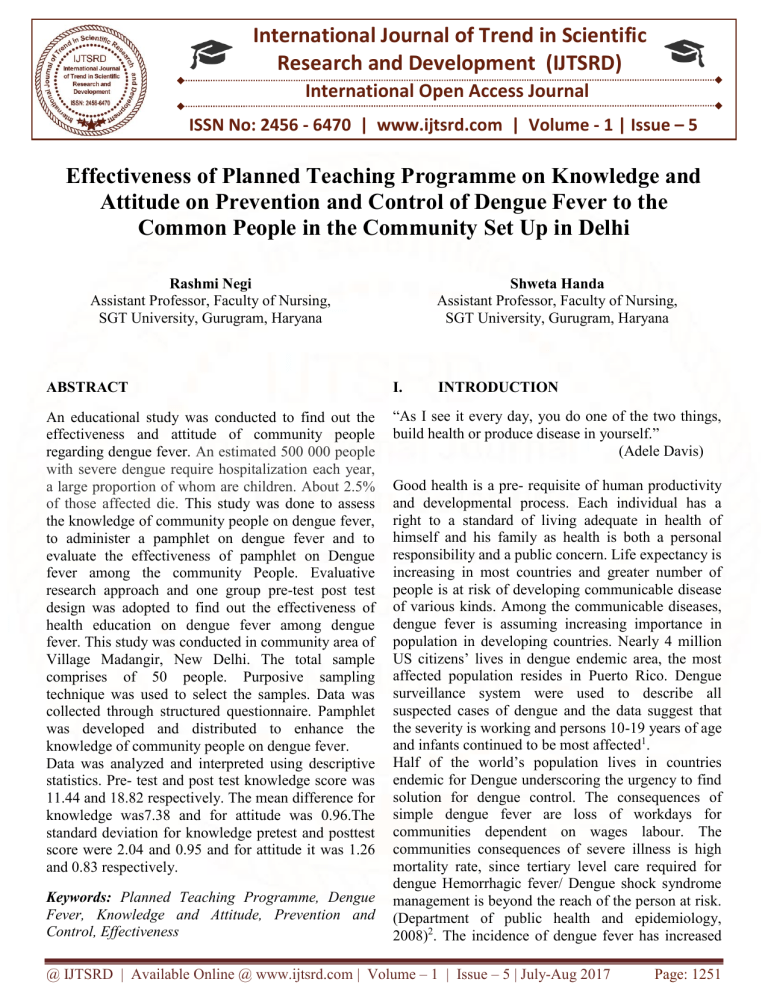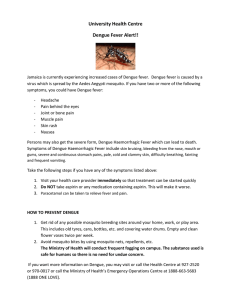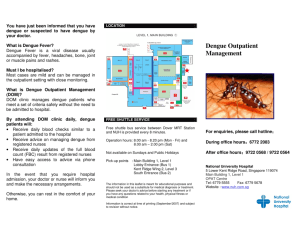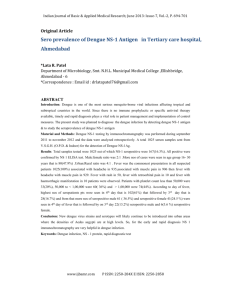
International Journal of Trend in Scientific
Research and Development (IJTSRD)
International Open Access Journal
ISSN No: 2456 - 6470 | www.ijtsrd.com | Volume - 1 | Issue – 5
Effectiveness of Planned Teaching Programme on Knowledge and
Attitude on Prevention and Control of Dengue Fever to the
Common People in the Community Set Up in Delhi
Rashmi Negi
Assistant Professor, Faculty of Nursing,
SGT University, Gurugram, Haryana
Shweta Handa
Assistant Professor, Faculty of Nursing,
SGT University, Gurugram, Haryana
ABSTRACT
I.
An educational study was conducted to find out the
effectiveness and attitude of community people
regarding dengue fever. An estimated 500 000 people
with severe dengue require hospitalization each year,
a large proportion of whom are children. About 2.5%
of those affected die. This study was done to assess
the knowledge of community people on dengue fever,
to administer a pamphlet on dengue fever and to
evaluate the effectiveness of pamphlet on Dengue
fever among the community People. Evaluative
research approach and one group pre-test post test
design was adopted to find out the effectiveness of
health education on dengue fever among dengue
fever. This study was conducted in community area of
Village Madangir, New Delhi. The total sample
comprises of 50 people. Purposive sampling
technique was used to select the samples. Data was
collected through structured questionnaire. Pamphlet
was developed and distributed to enhance the
knowledge of community people on dengue fever.
Data was analyzed and interpreted using descriptive
statistics. Pre- test and post test knowledge score was
11.44 and 18.82 respectively. The mean difference for
knowledge was7.38 and for attitude was 0.96.The
standard deviation for knowledge pretest and posttest
score were 2.04 and 0.95 and for attitude it was 1.26
and 0.83 respectively.
“As I see it every day, you do one of the two things,
build health or produce disease in yourself.”
(Adele Davis)
Keywords: Planned Teaching Programme, Dengue
Fever, Knowledge and Attitude, Prevention and
Control, Effectiveness
INTRODUCTION
Good health is a pre- requisite of human productivity
and developmental process. Each individual has a
right to a standard of living adequate in health of
himself and his family as health is both a personal
responsibility and a public concern. Life expectancy is
increasing in most countries and greater number of
people is at risk of developing communicable disease
of various kinds. Among the communicable diseases,
dengue fever is assuming increasing importance in
population in developing countries. Nearly 4 million
US citizens’ lives in dengue endemic area, the most
affected population resides in Puerto Rico. Dengue
surveillance system were used to describe all
suspected cases of dengue and the data suggest that
the severity is working and persons 10-19 years of age
and infants continued to be most affected1.
Half of the world’s population lives in countries
endemic for Dengue underscoring the urgency to find
solution for dengue control. The consequences of
simple dengue fever are loss of workdays for
communities dependent on wages labour. The
communities consequences of severe illness is high
mortality rate, since tertiary level care required for
dengue Hemorrhagic fever/ Dengue shock syndrome
management is beyond the reach of the person at risk.
(Department of public health and epidemiology,
2008)2. The incidence of dengue fever has increased
@ IJTSRD | Available Online @ www.ijtsrd.com | Volume – 1 | Issue – 5 | July-Aug 2017
Page: 1251
International Journal of Trend in Scientific Research and Development (IJTSRD) ISSN: 2456-6470
dramatically around the world in recent decades. The disease urge is of particular since there is no curative
actual numbers of total dengue cases are treatment for dengue. In many settings spray
underreported and many cases are misclassified due to application of insecticides or generalized community
lack of health facilities in the community. When cleanup campaign of vector breeding sites had only a
dengue first emerged in India during 50-60s it was transient and limited effect. In 2002 the WHO general
reported mild but the disease profile has changed and assembly confirmed dengue fever as a matter of
more severity was reported during the year 1980s. international public health priority through a
One recent data published in an article indicates that resolution to strengthen dengue control and research.
390 million dengue infections annually (95% credible (Dept. Public health and Epidemiology University,
interval 284–528 million), of which 96 million (67– 2008). Seasonal variation in the incidence of dengue
136 million) manifest clinically (with any severity of and large dengue outbreaks occurs every
disease).1 Another study, of the prevalence of dengue, years.(University of Georgia, 2009)4. Dengue fever is
estimates that 3.9 billion people, in 128 countries, are one of the most important emerging diseases of the
at risk of infection with dengue viruses which is really tropical and subtropical regions. Some 2.5-3 billion
a matter of concern3.
people lives in dengue endemic areas. It is estimated
that each year 50 millions infections occurs with
Only nine countries had experienced severe
500000 cases of DHF and at least 12000 deaths,
dengue epidemics during and before 1970. The
mainly among children although fatalities could be
disease is now endemic in more than hundred
twice as high. (Ministry of health and family welfare,
countries in the WHO regions of Africa, the
2008)5.
Americas, the Eastern Mediterranean, South-East
Asia and the Western Pacific. The America, SouthDengue fever has been diagnosed in an increasing
East Asia and Western Pacific regions are the most
proportion of febrile travelers returning from tropics,
seriously affected. Dengue was also reported in
ranging from 2% in the early 1990’s 16%. The
Japan after a lapse of over 70 years. Since it is a
dengue virus spreads rapidly and the disease develops
mosquito borne disease and is therefore directly
into the pandemic population. Most of the dengue
related to environmental sanitation, it can be
virus infection in the travelers is acquired in Asia
prevented by appropriate sanitation. The year 2015
followed by America, with only a small proportion in
was characterized by large dengue outbreaks
Africa. (The New England Journal of Medicine, 2002)
worldwide, with the Philippines reporting more
The annual average number of dengue
than 169 000 cases and Malaysia exceeding 111
fever/dengue haemorrhagic fever (DF/DHF) cases
000 suspected cases of dengue, representing a
reported to the World Health Organization (WHO)
59.5% and 16% increase in case numbers to the
has increased dramatically in recent years 6.
previous year, respectively. In Brazil over 1.5
Environmental management is generally considered to
million cases of dengue fever had been found in
be an essential component of dengue prevention and
2015, approximately 3 times higher than in 2014.
control, particularly when targeting the most
Delhi, India, has been recorded its worst outbreak
productive container habitats of the vector118. Source
since 2006 with over 15 000 plus cases. The
reduction, 'clean-up' campaigns, regular container
dengue epidemic in India last year resulted in high
emptying and cleaning (targeting not only households
mortality.
but also public spaces such as cemeteries, green areas
An estimated 500 000 people with severe dengue
and schools), installation of water supply systems,
require hospitalization each year, a large
solid waste management and urban planning all fall
proportion of whom are children. About 2.5% of
under the rubric of environmental management.
those affected die4.
However, huge investments in infrastructure are
needed to increase access to safe and reliable water
II.
BACKGROUND OF THE STUDY
supplies and solid waste disposal systems. In addition
to overall health gains, such provision would clearly
New scientific insight into dengue vector ecology and have a major impact on vector ecology, although the
disease transmission pattern together with more use of relationship is complex. For instance, cost recovery
environmental management strategies may offer mechanisms, such as the introduction of metered
improved potential for combating dengue fever , the water, might actually encourage the household
world’s fastest growing vector borne disease. This collection and storage of roof catchment rainwater,
@ IJTSRD | Available Online @ www.ijtsrd.com | Volume – 1 | Issue – 5 | July-Aug 2017
Page: 1252
International Journal of Trend in Scientific Research and Development (IJTSRD) ISSN: 2456-6470
which can be harvested at no cost. Although not
studied carefully, the construction of community
Knowledge
Score
water distribution services to rural townships and
Below Average
< 50%
villages might be contributing to the rural spread of
Average
50% -75%
dengue in Southeast Asia and elsewhere by
Above Average
>75%
facilitating domestic water storage. When decisions
on such infrastructure development are being made, 4. Planned
Teaching
Programme:
It
is
the views of Ministers of Public Health and municipal
systematically developed intervention and audio
health departments are seldom voiced loudly, even
visual aids designed for a group of common
when the economic and public health burden of
people to provide information on prevention and
diseases linked to water and sanitation are recognized,
control of dengue.
including those associated with dengue7.
III.
STATEMENT OF PROBLEM
A study to evaluate the effectiveness of planned
teaching programme on knowledge and attitude on
prevention and control of dengue fever to the common
people in the community set up in New Delhi
IV.
OBJECTIVES OF THE STUDY
1. To assess the knowledge of community people on
dengue fever.
2. To administer a pamphlet on dengue fever.
3. To evaluate the effectiveness of pamphlet on
Dengue fever among the community.
V.
OPERATIONAL DEFINITION:
1. Effectiveness: Refers to the extent to which the
exposure to planned teaching programme enables
the community people to gain knowledge from pre
test and post test as evident from knowledge
score.
VI.
CONCEPTUAL FRAMEWORK:
The conceptual framework adopted for the study is
based on Rosenstock’s (1974) Health Belief Model. It
provides a way of understanding and predicting how
individuals will behave in relation to the health to
comply with health education. The first component of
this model involves the individual perception of
susceptibility of risk factors of dengue fever. The
second component is the individual’s perception of
the seriousness of the risk factors of dengue fever.
This perception is influenced and modified by
demographic characteristics such as (age, educational
status, marital status, number of children, type of
family) and socio-psychological variables such as
social class of the individuals and perceived threat and
illnesses and areas to action using flash card and
pamphlets. The third components are the likelihood of
action that will take preventive action resulting from
the person’s perceptions of the benefits of health
education. The schematic representation of the
conceptual framework is given below:-
2. Attitude: Expression of feelings of community
people towards prevention and control of dengue
as evident from attitude scale.
Above Average: The attitude with score of
75% and above
Average: The attitude with score of 50%-75%
Negative Attitude: The attitude with score of
below 50%
3. Knowledge: In this study knowledge is defined as
the ability of people to respond to the items
correctly on a structured knowledge questionnaire
regarding prevention and control of dengue. The
score has been an average and above average
knowledge on the basis of response of the
participants.
@ IJTSRD | Available Online @ www.ijtsrd.com | Volume – 1 | Issue – 5 | July-Aug 2017
Page: 1253
International Journal of Trend in Scientific Research and Development (IJTSRD) ISSN: 2456-6470
VII.
CONCEPTUAL FRAMEWORK
CONCEPTUAL FRAMEWORK BASED ON
ROSENSTOCK’S HEALTH BELIEF MODEL
Individual perception
Modifying factors
Demographic factors &
socio psychological
variables age, educational
status, marital status, no.
Of children type of family
Perceived
susceptibility &
severity of
dengue disease
Likelihood of action
Perceivedbenefitsof
preventiveaction –
perceivedbarrier to
preventiveaction
Liklihood of
taking
recommended
preventive action
Perceived threat of dengue fever
Cues to action
Health Education on prevention
of risk factors of dengue fever
using flashcards & pampheletes
Figure1. Conceptual framework of the study based on Rosenstock’s Health Belief Model
VIII. MATERIALS AND METHODS:
Research Approach: Quantitative research approach was used in the present study.
Research Designs: The design selected for the study was one group pre-test post design.
RESEARCH DESIGN SHOWING
ONE GROUP PRE-TEST POST-TEST DESIGN
Assessment
of knowledge
on prevention
& control of
Dengue Fever
Health
Education to
the subjects
on prevention
& control of
dengue Fever
Assessment
of knowledge
on prevention
& control of
Dengue Fever
after health
Education
@ IJTSRD | Available Online @ www.ijtsrd.com | Volume – 1 | Issue – 5 | July-Aug 2017
Page: 1254
International Journal of Trend in Scientific Research and Development (IJTSRD) ISSN: 2456-6470
Figure2. Diagrammatic Representation of Research Design showing one group pre-test post-test design
Sample and sample size: The sample chosen for the
present study were homemakers (women) and the
sample size considered was 50.
Sampling Techniques: Purposive sampling technique
was used for the present study.
Description of Tool: The following tool was used for
the data collection:
Section 1: This section consists of Demographic
characteristics such as age, gender, marital status, type
of family, religion, educational status, occupational
status of husband, monthly income of family, health
care facility preferred by the family, sources of
maximum information regarding Dengue fever.
Section 2: This section consists of a knowledge
questionnaire on Dengue Fever.
Section 3: This section consists of attitude of
participants regarding prevention & control of Dengue
Fever.
Educational Module: The Educational Module was
developed with the support of various literature and
experts guidance. The module includes:➢
➢
➢
➢
➢
➢
➢
➢
➢
Introduction and background about Dengue Fever
Transmission
Epidemiology
Types of Dengue Fever
Etiology
Signs and symptoms
Diagnostic Evaluation
Treatment
Prevention
Data collection: The Data was collected by prior
permission from the concern authority. Oral consent
from participants was obtained and data were
collected by self administered questionnaire. The
study was conducted in Madangir area in New Delhi
for 5 days. Initially the researcher develops good
rapport with the participants and they were assembled
in a park, seated comfortably and questionnaire was
distributed to the sample. Researcher clearly
explained the questionnaire and distributed to the
participants. The duration of education was 25min.
Post test was done after 5 days.
Statistical Analysis: The collected data was
conveniently summarized and tabulated by using
descriptive statistics.
IX.
RESULTS:
The major findings of the study were as follows:
Section
1:
Description
of
the
sample
characteristics:
The socio demographic data of sample were describes
in terms of age, religion, marital status, type of
family, number of children, education, occupation,
monthly income and are presented in the forms of
graphs and tables.
Table 1: Percentage distribution of participants by
age N=50
Age in years
No.
of Percentage
participants
(%)
20-30
17
34
31-40
17
34
41-50
11
22
51 & above
05
10
Total
50
100
Table 2: Percentage distribution of participants by
educational status N=50
Educational
No.
of Percentage
Status
participants
(%)
Graduation
01
02
Higher
08
16
Secondary
25
50
High School
16
32
Illiterate
Total
50
100
Table 3: Percentage distribution of participants by
occupational status N=50
Occupational
No.
of Percentage
Status
participants
(%)
Private
06
12
Business
10
20
Others
34
64
Total
50
@ IJTSRD | Available Online @ www.ijtsrd.com | Volume – 1 | Issue – 5 | July-Aug 2017
100
Page: 1255
International Journal of Trend in Scientific Research and Development (IJTSRD) ISSN: 2456-6470
Table 4: Percentage distribution of participants by (88%) were married and 12% were unmarried. Out of
monthly income N=50
total percentage 56% of participants were living in a
nuclear family while 44% were in a joint family.
Monthly
Income No.
of Percentage
(In Rs.)
participants (%)
Section 2: Description of the knowledge score of
1000-5000
31
62
prevention and control of Dengue Fever
5001-10000
17
34
10001 and above
02
04
Table7. Comparison of Knowledge score on
Total
50
100
prevention and control of Dengue fever before and
Table 5: Percentage distribution of participants by
marital status N=50
Marital Status
No.
of Percentage
participants (%)
Married
44
88
Unmarried
06
12
Total
50
100
Table 6: Percentage distribution of participants by
Number of Children N=50
Number of children No.
of
participants
01
06
02
11
03
11
04
17
More
05
Total
50
Percentage
(%)
12
22
22
34
10
100
Table 7: Percentage distribution of participants by
Type of family N=50
Type of family
Joint
Nuclear
Total
No.
of
participants
22
28
50
Percentage
(%)
44
56
100
after health education
Mean
Pretest
Posttest
Mean
Difference
7.38
The data presented in the table 7 shows that the mean
posttest score was higher than the mean pretest
knowledge score. The mean pretest score was
11.44and increases to 18.82 during posttest with an
average increase of 7.38
Section 3: Description of the Attitude score of
prevention and control of Dengue Fever
Table 8.Comparison of Attitude score on
prevention and control of Dengue fever before and
after health education
Mean
Standard Mean
Deviation Difference
Pretest
8.28
1.26
0.96
Posttest
9.26
0.83
The data presented in the table 8 shows that the mean
post test attitude score was higher than the mean
pretest score. The mean pretest score was 8.28 which
increase to 9.26 during posttest with an average
increase of 0.96.
X.
The above data indicates that 34% of participants
were between 20-30 years and 31-40 years of age
group, 22% of participants belong to age group of 4150 years & of 10% of participants were in the age
group of above 51 years. Majority of the participants
(50%) had high school education, 32% were illiterate,
16% completed their higher secondary education and
only 2% were graduates. Maximum percentage (68%)
were homemakers, 205 had some business and 12%
of participants working in private sector. Majority of
the participants belongs to the income group of Rs.
1000-5000 and only participants had monthly income
group of Rs.10001-15000. Maximum participants
11.44
18.82
Standard
Deviation
2.04
0.95
CONCLUSION:
Dengue is now a global threat and is endemic or
epidemic in almost every country located in the
tropics. . Various methods to prevent and cure from
the prevalent condition is required .While we wait for
new tools such as vaccines, antiviral drugs and
improved diagnostics, better use should be made of
the interventions that are currently available. The
challenge that awaits us in the near future will be how
to scale up to deploy these new tools 6. Health
department officials said that dengue cases peak when
the virus that causes dengue — Flavivirus —
completes a cycle of three years. This is why higher
number of cases was recorded in 2009, 2012 and
@ IJTSRD | Available Online @ www.ijtsrd.com | Volume – 1 | Issue – 5 | July-Aug 2017
Page: 1256
International Journal of Trend in Scientific Research and Development (IJTSRD) ISSN: 2456-6470
again in the year 2015. Most of the cases were of resources in terms of times, money, men and
patients in the age group of 14 to 45 years8. Doctors materials. So that the services that are planned and
suggest using mosquito repellent, maintaining organized will be acceptable and accessible to all.
hygiene, keeping ones surroundings clean, wearing Focus should be on facilitating the services and
full-sleeved clothes and avoiding water accumulation motivating each health personnel to provide cost
anywhere around homes or workplaces as preventive effective services.
measures. The larvae of aedes mosquito were found in
coolers, planters and water tanks in homes. Dengue is Nursing Research: Extensive and intensive
emerging as a global threat and it is affecting tens of researches are required to fight against dengue fever
millions people annually and the need to bring it in the long run. As it an important issue related to
under control is very acute9. Dengue epidemics are health, we need to develop alternative method to deal
frequent in India during the Monsoon which has no with it. The nurse researcher should take up
specific treatment and no vaccine is yet available10. researches in various aspects of dengue fever and its
On the basis of the findings of the above study prevention to generate more reliable data to give
conclusion can be made that community people still guidelines to the public for health education in various
have deficient knowledge regarding dengue fever with settings.
a varying degree and health education was found to be
XII. RECOMMENDATIONS:
effective in increasing knowledge regarding dengue
1. A similar study can be done on a wider sample
fever. The pamphlets were found to be highly
in different settings to generalize the findings.
effective and acceptable by the people. Moreover
2. A comparative study can be carried out to
provision of pamphlet has played a vital role in
ascertain the knowledge and attitude about
maintaining and reducing the effect of dengue fever in
dengue fever among the community people in a
the community.
community setting.
3.
A descriptive study can be undertaken to assess
XI.
IMPLICATION:
the knowledge and attitude of the people in
The finding of the study had varied implications in
community area.
different areas of nursing practice, nursing
4.
A similar study can be conducted to compare the
administration, nursing education and nursing
effectiveness of planned teaching programme
research.
with that of pamphlet.
Nursing Education: Nursing is a profession which
deals with people and their physical needs. Health REFERENCES:
does not specify to a single person but yield to the 1) Chan.M.2012. Global strategy for dengue
entire community. So a nurse while dealing with the
prevention
and
control,
World
Health
public health can educate them about the Dengue
Organisation. P.g- 1-8
fever. The Module can be used as reference material 2) World Health Organization. April 2017.
by the student nurses.
Available
from:
URL:
Nursing Practice: The study provided an insight into
the inadequacy of knowledge of community people
regarding dengue fever. Thus there is a need to
emphasize on community teaching programme. So the
community health nurse should be actively
participating towards the development of health of the
community as a whole. To sensitize people about the
issues related to health education programme should
be conducted in a variety of community settings in a
large scale.
Nursing Administration: While planning nursing
services at a large scale administration should focus
on the epidemiological factors related to health
conditions, social factors influencing the health issues,
3)
4)
5)
6)
http://www.who.int/mediacentre/factsheets/fs117/
en/
Bhatt S, Gething PW, Brady OJ, Messina JP,
Farlow AW, Moyes CL et.al. The global
distribution
and
burden
of
dengue.
Nature;496:504-507
Mariam Zameer. July 2013. Knowledge, attitudes
and practices study of dengue viral infection and
its association with environmental factors and
health issues. Vol.7(7), P.P-711-717
Gupta N. Srivastava S. September 2012. Dengue
in India. Indian J Med Res 136, September 2012
P.p-373-390.
Key.M.Tomasheh
and
AidshaRiveria.
2009.Description of large island-wide outbreak of
@ IJTSRD | Available Online @ www.ijtsrd.com | Volume – 1 | Issue – 5 | July-Aug 2017
Page: 1257
International Journal of Trend in Scientific Research and Development (IJTSRD) ISSN: 2456-6470
dengue in Puerto Rico. The American Journal of 8) Gupta N, Srivastava S, Jain A, Chaturvedi UC.
Tropical Medicine and Hygiene.
Dengue in India. Indian J Med Res.
7) Sinha S. 2016. Sinha S. 2016. Available from:
2012;136(3):373-90. Review.
URL:
9) Park.K. Preventive & social Medicine, Banarsidas
http://www.hindustantimes.com/topic/dengueBhanot Publishers, Ed. 19, Pg. 651-57
deaths.
10) Karen Saucier Lundy, Community health nursing,
care of public health, Jones and Bartlett
Publishers,368-72
@ IJTSRD | Available Online @ www.ijtsrd.com | Volume – 1 | Issue – 5 | July-Aug 2017
Page: 1258






